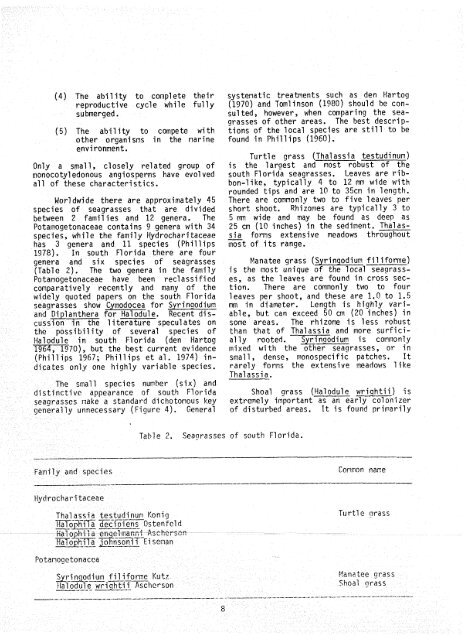The Ecology of the Seagrasses of South Florida - USGS National ...
The Ecology of the Seagrasses of South Florida - USGS National ...
The Ecology of the Seagrasses of South Florida - USGS National ...
Create successful ePaper yourself
Turn your PDF publications into a flip-book with our unique Google optimized e-Paper software.
(4) <strong>The</strong> ability to complete <strong>the</strong>ir systematic treatments such as den Hartog<br />
reproductive cycle while fully (1970) and Tomlinson (1980) should be consubmerged<br />
. sulted, however, when comparing <strong>the</strong> seagrasses<br />
<strong>of</strong> o<strong>the</strong>r areas. <strong>The</strong> best descrip-<br />
(5) <strong>The</strong> ability to compete with<br />
o<strong>the</strong>r organism in <strong>the</strong> narine<br />
tions <strong>of</strong> <strong>the</strong> local species are still to he<br />
found in Phil1 ips (1960).<br />
environment.<br />
Turtle grass (Thal assia testudinum)<br />
Only a small, closely related group <strong>of</strong> is <strong>the</strong> largest and most robust <strong>of</strong> <strong>the</strong><br />
monocotyledonous angiosperms have evolved south <strong>Florida</strong> seagrasses. Leaves are riball<br />
<strong>of</strong> <strong>the</strong>se characteristics. bon-like, typically 4 to 12 rnm wide with<br />
rounded tips and are 10 to 35cm in length.<br />
h'orldwide <strong>the</strong>re are approximately 45 <strong>The</strong>re are commonly two to five leaves per<br />
species <strong>of</strong> seagrasses that are divided short shoot. Rhizomes are typically 3 to<br />
between 2 famil ies and 12 genera. <strong>The</strong> 5 m wide and may be found as deep as<br />
Potamogetonaceae contains 9 genera with 34 25 cm (10 inches) in <strong>the</strong> sediment. Thalas-<br />
species, while <strong>the</strong> family Hydrochari taceae sia forms extensive meadows throughout<br />
has 3 genera and 11 species (Phillips most <strong>of</strong> its range.<br />
1978). In south <strong>Florida</strong> <strong>the</strong>re are four<br />
genera and six species <strong>of</strong> seagrasses Manatee grass (Syringodium f il ifome)<br />
(Table 2). <strong>The</strong> two genera in <strong>the</strong> family is <strong>the</strong> nost unique <strong>of</strong> <strong>the</strong> local seagrass-<br />
Potanogetonaceae have been reclassified es, as <strong>the</strong> leaves are found in cross seccomparatively<br />
recently and many <strong>of</strong> <strong>the</strong> tion, <strong>The</strong>re are commonly two to four<br />
widely quoted papers on <strong>the</strong> south <strong>Florida</strong> leaves per shoot, and <strong>the</strong>se are 1.0 to 1.5<br />
seagrasses show Qmodocea for Syrinaodiurn mm in diameter. Length is highly variand<br />
Dipfan<strong>the</strong>ra for Halodule. Recent dis- able, hut can exceed 50 cm (20 inches) in<br />
cussion in <strong>the</strong> literature speculates on some areas, <strong>The</strong> rhizome is less rohust<br />
<strong>the</strong> possibility <strong>of</strong> several species <strong>of</strong> than that <strong>of</strong> Thalassia and more surfici-<br />
Halodule in south <strong>Florida</strong> (den Hartog ally rooted. Syringodium is covmonly<br />
=70), but <strong>the</strong> best current evidence mixed with <strong>the</strong> o<strong>the</strong>r seagrasses, or in<br />
(Phillips 1967; Phillips et al. 1374) in- small, dense, monospecific patches, It<br />
dicates only one highly variable species. rarely foms <strong>the</strong> extensive meadows 1 ike<br />
Thal assi a.<br />
<strong>The</strong> small species numher (six) and<br />
di sti nctivc appearance <strong>of</strong> south <strong>Florida</strong> Shoal grass (Halodule wrightii) is<br />
seagrasses make a standard dichotonous key extremely important as an early colonizer<br />
generally unnecessary (Figure 4). General <strong>of</strong> disturbed areas. It is found primarily<br />
Table 2. Sea?rasses <strong>of</strong> south <strong>Florida</strong>.<br />
-.- --<br />
Family and species<br />
Hydrochari taceae<br />
Conmon name<br />
-....-- . ---- --- -

















